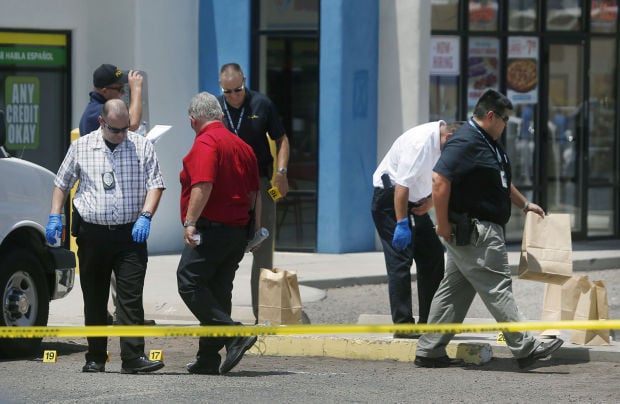Tucsonans are significantly safer than they were 20 years ago. Their property? Not so much.
Despite falling crime rates both nationally and locally, the community still has a major blemish on its public-safety résumé when it comes to thefts, burglaries, arsons and auto thefts.
The recently released FBI Uniform Crime Report for 2013 shows the Tucson region has the 10th-highest property-crime rate among metropolitan areas with at least 100,000 people.
Like most of the country, property crime here is down. But it has not fallen nearly as much as it has in most other communities.
The Tucson area’s property-crime rate is 4,849 per 100,000 residents. The national average for metro areas of more than 100,000 people is 2,730 per 100,000 residents.
At its peak in the mid-1990s, Tucson’s property-crime rate hit 8,892 per 100,000 residents — then nearly double the national average.
One factor that plays into the region’s high property-crime rate is the highly transient population.
“It’s not just moving in or out, it’s also that population moving within a metropolitan area, like Tucson, certainly has something to do with property crimes,” said Scott Decker, foundation professor at Arizona State University’s School of Criminology and Criminal Justice.
The Tucson region is highly transient. The average Tucsonan moves every 3.5 years, compared to the national average of 5.2 years, data from the Pima Association of Governments show.
Over 80 percent of renters have lived at their present address less than 18 months, PAG data shows.
“The issue for population mobility is it makes it more difficult for people to know their neighbors,” Decker said. “It makes it more difficult for people to know what’s normal for a neighborhood; who belongs there and who doesn’t and who might be up to no good. When there’s a lot of mobility, those things are more difficult to get a handle on.”
While property crime remains high when compared to other regions, it is down significantly, largely because of the dramatic drop in auto thefts. In 1995, the region reported more than 7,450 auto thefts. By 2013, that figure had fallen to 3,030.
VIOLENT CRIME DECLINES
Along with auto theft, the FBI calculates property crime by compiling instances of burglary, larceny-theft and arson.
Sgt. Pete Dugan of the Tucson Police Department said modern anti-theft devices on newer cars have made it more difficult for thieves to steal them. Larceny and burglary also have been on the decline.
Like property crime, the rate of violent crime also has declined almost annually since the 1990s. The FBI compiles stats on murder and non-negligent manslaughter, rape, robbery and aggravated assault to calculate violent crime.
There’s no single reason to account for the drop in violent crime. Various studies point to an improving economy, more concealed-weapons laws, gun-control regulation, more police, higher incarceration rates and changing demographics.
“It’s a complicated story with no easy answer,” ASU’s Decker said.
He said smarter policing and prisons certainly accounted for a portion of the drop.
“It’s not just locking people up. It’s about who you lock up,” he said. “It’s about using prison for the most crime-prone groups. It has more to do with smart sentencing than locking people up.”
One of the biggest factors for the decline is an aging population, Decker said.
“The percent of the population that you have between 18 to 30 years old makes a big difference,” he said.
The Tucson region’s population has been growing slightly older over the past 15 years. In 2000, the median age in the region was 35. By the 2010 Census, the median age had increased to 37.
“We’re an aging country,” Pima County sheriff’s Chief Deputy Chris Nanos said. “And the least likely group to be involved in crime is the elderly.”
In addition to infrequent forays into crime, the elderly are also more engaged with their neighborhood and community, Nanos said. He pointed to areas such as Saddlebrooke and Green Valley as examples.
“Because they get involved with their communities, that reflects in their low crime rates,” Nanos said. “If you have any community involved in a problem, crime drops.”
REALITIES, GOOD AND BAD
The connection between crime and immigration has been the subject of much speculation.
Despite rhetoric surrounding immigration and crime, Decker said the numbers show that higher populations of Hispanics correlate to lower crime rates.
Areas with higher Hispanic populations, such as the Southwest, tend to experience fewer crimes than Eastern or Midwest cities, he said.
While the continued drop in crime rates has been a welcome trend, crime still is an issue that has raised concerns among the region’s business community.
Mike Varney, president and CEO of the Tucson Metro Chamber, said crime turned up as a main concern in a study the group plans to release next week.
“Crime was a straight negative across the board,” in the chamber’s “Community Quality Report Card,” Varney said.
When the region has crime rates above the national average, it creates a more difficult environment for businesses to thrive. But Varney said the chamber believes that improving the regional economy would in the long run help reduce crime.
This year’s crime report was the first of the FBI’s annual reports since 2005 that included data on the property crimes for the city of Tucson or the metro area.
For seven years, reports left categories for larceny and property crime blank for Tucson, with a notation stating: “The FBI determined that the agency did not follow national Uniform Crime Reporting (UCR) Program guidelines for reporting an offense.”
During that seven-year gap, the Tucson Police Department reported property crime in a way the FBI did not recognize. Adjustments have been made to account for those crimes, although TPD officials did not respond to a request late last week to explain their changes.





